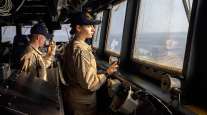Oil Train Crash Adds Pressure for New Safety Standards
Video images of a fireball billowing from the wreckage of a derailed train hauling Bakken crude are adding to pressure on federal regulators to act on new safety standards for oil shipments.
While there were no fatalities in the CSX Corp. accident in rural West Virginia on Feb. 16, the footage of flames and smoke rekindles public alarm over the prospect of tank cars rumbling through urban areas, according to a former U.S. Transportation Department official and a railroad consultant.
“It weakens the railroad’s and the industry’s ability to argue on the merits” to shape any government decision, Brigham McCown, a former chief of the Pipeline and Hazardous Materials Safety Administration, said by phone Tuesday. “In Washington, D.C., perception is reality. Railroads have to get a handle on what’s causing these derailments and they have to fix it.”
The Transportation Department missed a target to produce comprehensive rules for crude safety by the end of 2014 amid lobbying from railroads, oil producers and tank-car owners and makers. Now, the final regulations will be crafted amid fresh visual reminders about the flammability of Bakken crude, which often moves by rail because of a lack pipeline connections.
“It looks terrible. From a momentum issue, it’s not good news,” said Anthony Hatch, a former Wall Street railroad analyst and the founder of ABH Consulting in New York. “It brings that debate back to the front page.”
“@PBow25: Crazy pic of Boomer, WV sent to me by @mattyvhs_10. Scary stuff... #wvderail pic.twitter.com/woOTaBHL6g”
— Appalachian Magazine (@appalachianmag) February 16, 2015
The derailment Feb. 16 was the second in North America in less than 48 hours. Seven crude cars on a Canadian National Railway Co. train caught fire late Feb. 14 near Gogama, Ontario, and the company’s main line remained blocked Feb. 17, according to the Via Rail Canada passenger service.
One difference between the crashes: The Canadian crash occurred just before midnight in a remote area, while the West Virginia derailment came in daylight less than 30 miles (48 kilometers) from the state capital, Charleston.
“This accident is another reminder of the need to improve the safety of transporting hazardous materials by rail,” Christopher Hart, acting chairman of the National Transportation Safety Board, said in an e-mailed statement. “If we identify any new safety concerns as a result of this derailment, the board will act expeditiously to issue new safety recommendations.”
May is the new target to complete U.S. rulemaking, according to the Transportation Department, which has delayed regulations that Secretary Anthony Foxx once said he wanted in place before the end of 2014. U.S. and Canadian authorities began discussing oil-train upgrades after derailments including the 2013 accident that killed 47 people in Quebec.
“The federal government should not delay further,” Peter DeFazio of Oregon, the top Democrat on the House Transportation Committee, said Tuesday in a statement. “It must issue the new rules for safer rail tank cars as soon as possible.”
In Monday’s crash, residents near the town of Mount Carbon were forced to flee their homes in frigid weather and leaking crude oil threatened the water supply from the Kanawha River. Ten months ago, a CSX train carrying Bakken crude derailed in downtown Lynchburg, Virginia, catching fire and spilling crude in the James River.
One person was treated for possible respiratory problems, according to CSX, the largest U.S. Eastern railroad. CSX said the cause remains under investigation.
pic.twitter.com/kUVJF4AMWB
— Mikey Scarbrough (@scarbroughmikey) February 16, 2015
For New York State Assemblyman Phillip Steck, the derailment offered a reminder about the danger from oil trains traversing his densely populated upstate district near Albany.
“A fireball like that could destroy the whole community,” Steck said. “It’s a real concern.”
Oil from the Bakken shale formation in North Dakota needs to be processed at the production site to remove the volatile chemicals that make it so explosive, said Steck, a Democrat. Such a step would go beyond the U.S. rules now under discussion, which center on strengthening the cars carrying the crude.
According to the original Transportation Department proposal in July, tank cars would have to be replaced or significantly modified within two years. Tank-car owners objected, saying the industry lacked the factory capacity to meet such an aggressive timetable.
Those owners would have years longer to refresh their fleets under a revised Transportation Department proposal that has been sent to the White House for review but which hasn’t been made public, people familiar with the matter have said.
The cars seen by investigators to be the most vulnerable to rupture, known as DoT-111s, would face the first deadlines for retrofits. Newer cars known as CPC-1232s, which the industry voluntarily agreed to build in late 2011 in response to safety concerns, would be in use for years longer, according to people familiar with the draft rule sent to the White House.
In West Virginia, the derailed crude train was hauling CPC-1232 cars, according to Jacksonville, Florida-based CSX.
Monday’s accident also raises questions over whether any tank car is safe enough to withstand a derailment at speeds of 40 miles per hour or more, said Bob Pickel, a senior vice president of marketing and sales for National Steel Car, a Canadian railcar maker based in Hamilton, Ontario.
The CSX train had CPC-1232 cars with either an extra steel jacket or were made of half-inch steel instead of the usual 7/16-inch thickness. Those cars are supposed to only have a 4.6% chance of spilling 100 gallons or more in an accident compared with older models that have a 20% release rate, according to a study by the Association of American Railroads.
Photo from Emily Hardy of flames shooting in the air at train derailment in #FayetteCounty #EyewitnessWV pic.twitter.com/osWwH9RncP
— Eyewitness News (@wchs8fox11) February 16, 2015




